Static Electricity
Static Electricity
Static electricity is the build up of an electrical charge on the surface of an object. It's called "static" because the charges remain in one area for a while rather than moving or "flowing" to another area.
We see static electricity every day. It can even build up on us. For example, when we rub our feet on the carpet and then zap something when we touch it. That is static electricity that we have built up on the surface of our skin discharging onto another object. We also see it when our hair gets charged and sticks straight up or when our pant legs keep sticking to our legs no matter what we try and do. This is all static electricity that has built up on the surface of an object.
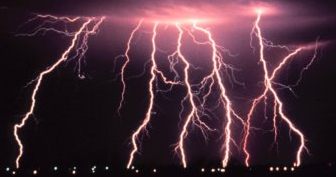
Lightning is a powerful form of static electricity
What is static electricity?
In the study of atoms we learned that atoms are made up of neutrons, protons, and electrons. The electrons are spinning around the outside. A static charge is formed when two surfaces touch each other and the electrons move from one object to another. One object will have a positive charge and the other a negative charge. Rubbing the items quickly, like when you rub a balloon fast over something or your feet on the carpet, will build up a large charge. Items with different charges (positive and negative) will attract, while items with similar charges (positive and positive) will push away from each other. Sort of like a magnet.
Remember when you've gone down a slide and all your hair stands up straight. This is because the friction of sliding has caused a positive charge to be built up on each hair. Since each hair has the same charge, they all try to push away from each other and end up standing up straight.
Likewise, when your skin is charged with static electricity and you touch something metal, like a door handle, the metal is very conductive and will quickly discharge the static electricity, creating a zap or small spark.
Does it have any real uses?
Static electricity has several uses, also called applications, in the real world. One main use is in printers and photocopiers where static electric charges attract the ink, or toner, to the paper. Other uses include paint sprayers, air filters, and dust removal.
It can damage electronics
Static electricity can also cause damage. Some electronic chips, like the kind that are in computers, are very sensitive to static electricity. There are special bags to store these in. Also, people that work with these kind of electronics wear special straps that keep them "grounded" so they won't build up charge and ruin the electronic components.
Fun facts about static electricity
A spark of static electricity can measure thousands of volts, but has very little current and lasts for a short period of time. This means it has little power or energy.
- Lighting is a powerful and dangerous example of static electricity.
- As dangerous as lighting is, around 70% of people struck by lightning survive.
- Temperatures in a lightning bolt can hit 50,000 degrees F.
- Static electricity will be worse on a dry non-humid day.

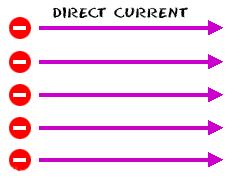 There are two main types of current in our world. One is direct current (DC) which is a constant stream of charges in one direction. The other is alternating current (AC) that is a stream of charges that reverses direction. Let's look at DC power which was refined by Thomas Edison in the 1800s.
There are two main types of current in our world. One is direct current (DC) which is a constant stream of charges in one direction. The other is alternating current (AC) that is a stream of charges that reverses direction. Let's look at DC power which was refined by Thomas Edison in the 1800s. Electrons move from areas where there are excess of negative charges to areas where there are a deficiency (or positive charge). Electrons move from "-" to "+", but conventional current is considered to move in the other direction. When you set up a circuit, conventional current is considered to move from the "+" to the "-" side.
Electrons move from areas where there are excess of negative charges to areas where there are a deficiency (or positive charge). Electrons move from "-" to "+", but conventional current is considered to move in the other direction. When you set up a circuit, conventional current is considered to move from the "+" to the "-" side.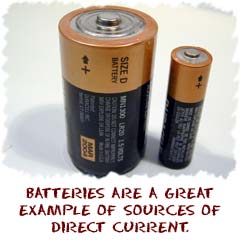 The best real-life example of direct current is a battery. Batteries have positive (+) and negative (-) terminals. If you take a wire and connect the positive and negative terminals on a battery, the electrons in the wires will begin to flow to produce a current. You can prove that the current is flowing if you connect a small light to the circuit. The light will begin to glow as the electrons pass through the filaments.
The best real-life example of direct current is a battery. Batteries have positive (+) and negative (-) terminals. If you take a wire and connect the positive and negative terminals on a battery, the electrons in the wires will begin to flow to produce a current. You can prove that the current is flowing if you connect a small light to the circuit. The light will begin to glow as the electrons pass through the filaments. 



 A magnet is an object or a device that gives off an external
A magnet is an object or a device that gives off an external 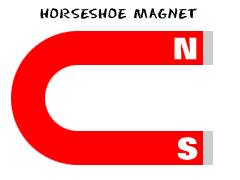 There are many different types of magnets. Permanent magnets never lose their magnetism. There are materials in the world that are called ferromagnetic. Those materials are able to create and hold a specific alignment of their atoms. Since many atoms have a magnetic moment (tiny magnetic field), all of the moments can add up to create a magnet. Scientists use the word hysteresis to describe the way the atoms stay aligned.
There are many different types of magnets. Permanent magnets never lose their magnetism. There are materials in the world that are called ferromagnetic. Those materials are able to create and hold a specific alignment of their atoms. Since many atoms have a magnetic moment (tiny magnetic field), all of the moments can add up to create a magnet. Scientists use the word hysteresis to describe the way the atoms stay aligned.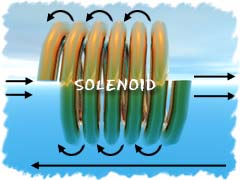 Electromagnets are different because they have a ferromagnetic material (usually iron or steel) located inside of the coils of wire. The core isn't air, it is something that aids in producing magnetic effects, so electromagnets are typically stronger than a comparable air-core magnet. Air-core and electromagnets can be turned on and off. They both depend on currents of electricity to give them magnetic characteristics. Not only can they be turned on and off, but they can also be made much stronger than ordinary magnets. You might see an electromagnet at work in a junkyard lifting old cars off the ground.
Electromagnets are different because they have a ferromagnetic material (usually iron or steel) located inside of the coils of wire. The core isn't air, it is something that aids in producing magnetic effects, so electromagnets are typically stronger than a comparable air-core magnet. Air-core and electromagnets can be turned on and off. They both depend on currents of electricity to give them magnetic characteristics. Not only can they be turned on and off, but they can also be made much stronger than ordinary magnets. You might see an electromagnet at work in a junkyard lifting old cars off the ground.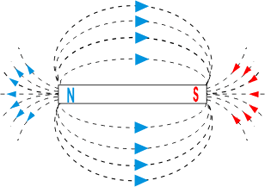


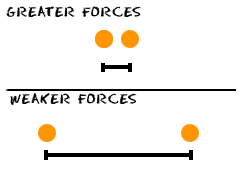 Think about a few concepts before you continue reading. Some charges are attracted to each other. Positive and negative charges like to move towards each other. Similar charges such as two positive or two negative push away from each other. You also need to understand that forces between objects become stronger as they move together and weaker as they move apart. You could yell at someone from far away, and they would barely hear you. If you yelled the same amount when you were together, it would be more powerful and loud.
Think about a few concepts before you continue reading. Some charges are attracted to each other. Positive and negative charges like to move towards each other. Similar charges such as two positive or two negative push away from each other. You also need to understand that forces between objects become stronger as they move together and weaker as they move apart. You could yell at someone from far away, and they would barely hear you. If you yelled the same amount when you were together, it would be more powerful and loud.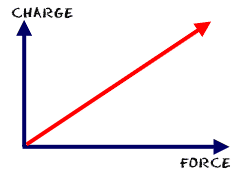 But you're here to learn about the law. When you have two charged particles, an electric force is created. If you have larger charges, the forces will be larger. If you use those two ideas, and add the fact that charges can attract and repel each other you will understand Coulomb's Law. It's a formula that measures the electrical forces between two objects.
But you're here to learn about the law. When you have two charged particles, an electric force is created. If you have larger charges, the forces will be larger. If you use those two ideas, and add the fact that charges can attract and repel each other you will understand Coulomb's Law. It's a formula that measures the electrical forces between two objects.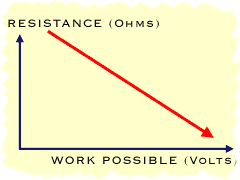 The symbol "V" is used to represent something called the potential difference. Potential difference is the amount of work done in moving a charge between two points, divided by the size of the charge. That's kind of complicated, though. You can think of potential as electrical height. High potential (near positive charge) is kind of like being on top of a hill. Low potential (near negative charge) is kind of like being in a valley. So potential difference indicates the difference in electrical height between two points. The greater that difference, the more likely it is that charge will move. The potential difference is measured in volts, and potential is commonly referred to as voltage. "I" is the symbol for current and "R" is the symbol for the resistance of the system. Current is measured in amperes and resistance is measured in ohms.
The symbol "V" is used to represent something called the potential difference. Potential difference is the amount of work done in moving a charge between two points, divided by the size of the charge. That's kind of complicated, though. You can think of potential as electrical height. High potential (near positive charge) is kind of like being on top of a hill. Low potential (near negative charge) is kind of like being in a valley. So potential difference indicates the difference in electrical height between two points. The greater that difference, the more likely it is that charge will move. The potential difference is measured in volts, and potential is commonly referred to as voltage. "I" is the symbol for current and "R" is the symbol for the resistance of the system. Current is measured in amperes and resistance is measured in ohms.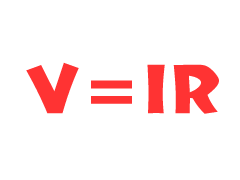 Let's go back to that equation and look at it in terms of resistance. When you move the values around you get R=V/I. In English that means the resistance of a system is based on voltage and current. Not all conductors follow Ohm's law.
Let's go back to that equation and look at it in terms of resistance. When you move the values around you get R=V/I. In English that means the resistance of a system is based on voltage and current. Not all conductors follow Ohm's law. Electric current is very similar to a flowing river. The river flows from one spot to another and the speed it moves is the speed of the current. The size of the current flow is related more to the size of the river than it is to the speed of the river. A river carries more water each second than a stream, even if both flow at the same speed. With electricity, current is a measure of the amount of charge transferred over a period of time. Current is a flow of electrons, or individual negative charges. When charge flows, it carries energy that can be used to do work. Scientists measure current with units called amperes.
Electric current is very similar to a flowing river. The river flows from one spot to another and the speed it moves is the speed of the current. The size of the current flow is related more to the size of the river than it is to the speed of the river. A river carries more water each second than a stream, even if both flow at the same speed. With electricity, current is a measure of the amount of charge transferred over a period of time. Current is a flow of electrons, or individual negative charges. When charge flows, it carries energy that can be used to do work. Scientists measure current with units called amperes. 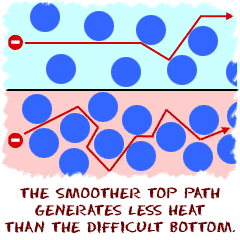 One of the results of current is the heating of the conductor. When an electric stove heats up, it's because of the flow of current. The electrons have a mass (however small), and when they move through the conductor, there are collisions that produce heat. The more electrons bumping into the atoms of the conductor, the more heat is created, so higher current generally means greater heat.
One of the results of current is the heating of the conductor. When an electric stove heats up, it's because of the flow of current. The electrons have a mass (however small), and when they move through the conductor, there are collisions that produce heat. The more electrons bumping into the atoms of the conductor, the more heat is created, so higher current generally means greater heat.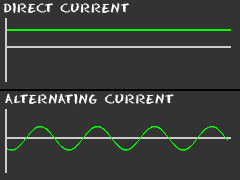 There are two main kinds of electric current, direct current (DC) and alternating current (AC). They are easy to remember. Direct current is a flow of charge always in one direction. Alternating current is a flow of charge back and forth, changing its direction many times in one second. Batteries produce DC current, while the outlets in our homes use AC current.
There are two main kinds of electric current, direct current (DC) and alternating current (AC). They are easy to remember. Direct current is a flow of charge always in one direction. Alternating current is a flow of charge back and forth, changing its direction many times in one second. Batteries produce DC current, while the outlets in our homes use AC current.
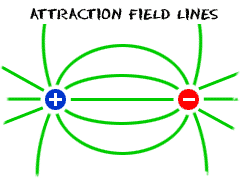 Magnetic fields are different from electric fields. Although both types of fields are interconnected, they do different things. The idea of magnetic field lines and magnetic fields was first examined by Michael Faraday and later by James Clerk Maxwell. Both of these English scientists made great discoveries in the field of electromagnetism.
Magnetic fields are different from electric fields. Although both types of fields are interconnected, they do different things. The idea of magnetic field lines and magnetic fields was first examined by Michael Faraday and later by James Clerk Maxwell. Both of these English scientists made great discoveries in the field of electromagnetism.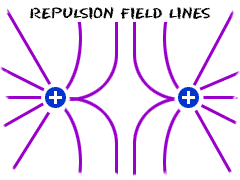 If you place an object in a magnetic field, it will be affected, and the effect will happen along field lines. Many classroom experiments watch small pieces of iron (Fe) line up around magnets along the field lines. Magnetic poles are the points where the magnetic field lines begin and end. Field lines converge or come together at the poles. You have probably heard of the poles of the Earth. Those poles are places where our planets field lines come together. We call those poles north and south because that's where they're located on Earth. All magnetic objects have field lines and poles. It can be as small as an atom or as large as a star.
If you place an object in a magnetic field, it will be affected, and the effect will happen along field lines. Many classroom experiments watch small pieces of iron (Fe) line up around magnets along the field lines. Magnetic poles are the points where the magnetic field lines begin and end. Field lines converge or come together at the poles. You have probably heard of the poles of the Earth. Those poles are places where our planets field lines come together. We call those poles north and south because that's where they're located on Earth. All magnetic objects have field lines and poles. It can be as small as an atom or as large as a star.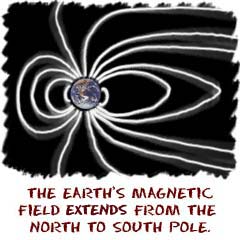 Magnets are simple examples of natural magnetic fields. But guess what? The Earth has a huge magnetic field. Because the core of our planet is filled with molten iron (Fe), there is a large field that protects the Earth from space radiation and particles such as the solar wind. When you look at tiny magnets, they are working in a similar way. The magnet has a field around it.
Magnets are simple examples of natural magnetic fields. But guess what? The Earth has a huge magnetic field. Because the core of our planet is filled with molten iron (Fe), there is a large field that protects the Earth from space radiation and particles such as the solar wind. When you look at tiny magnets, they are working in a similar way. The magnet has a field around it.